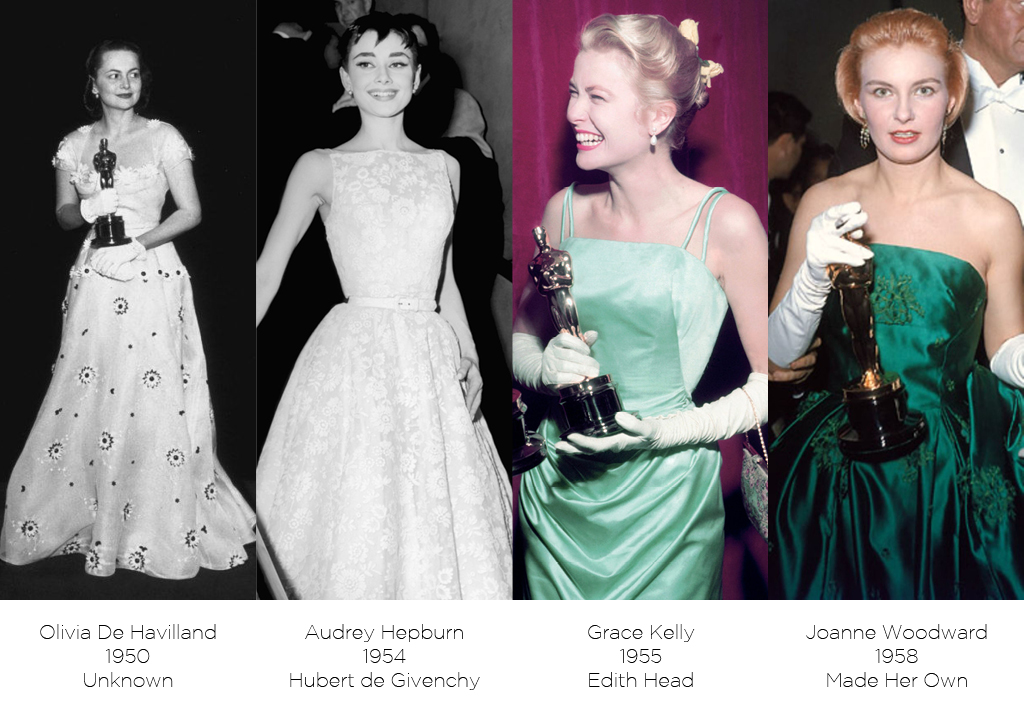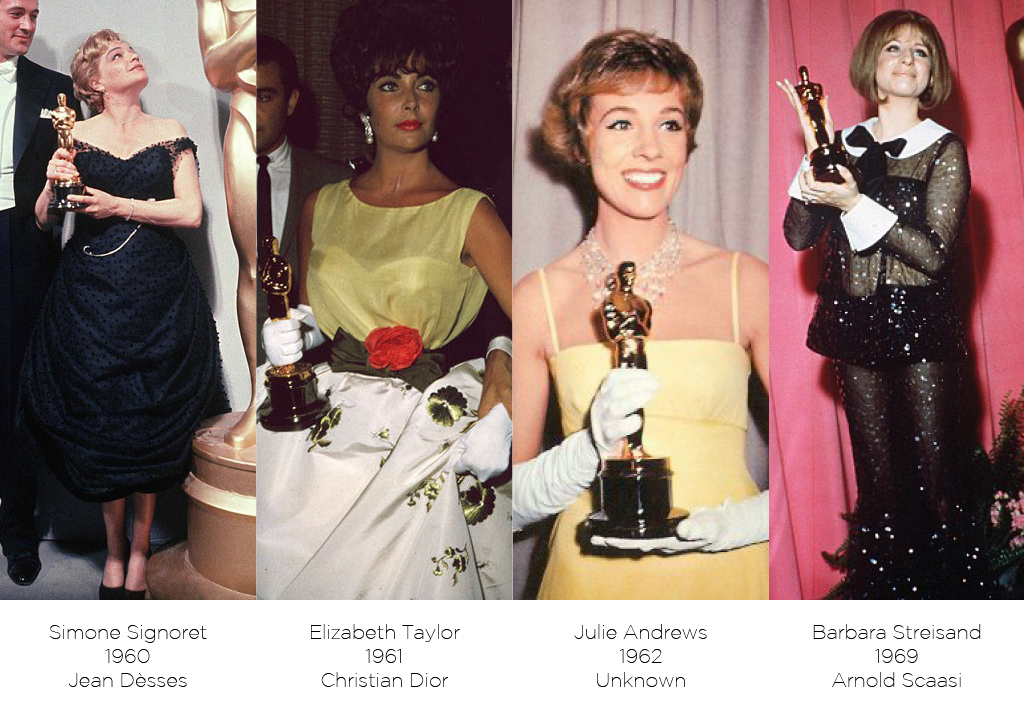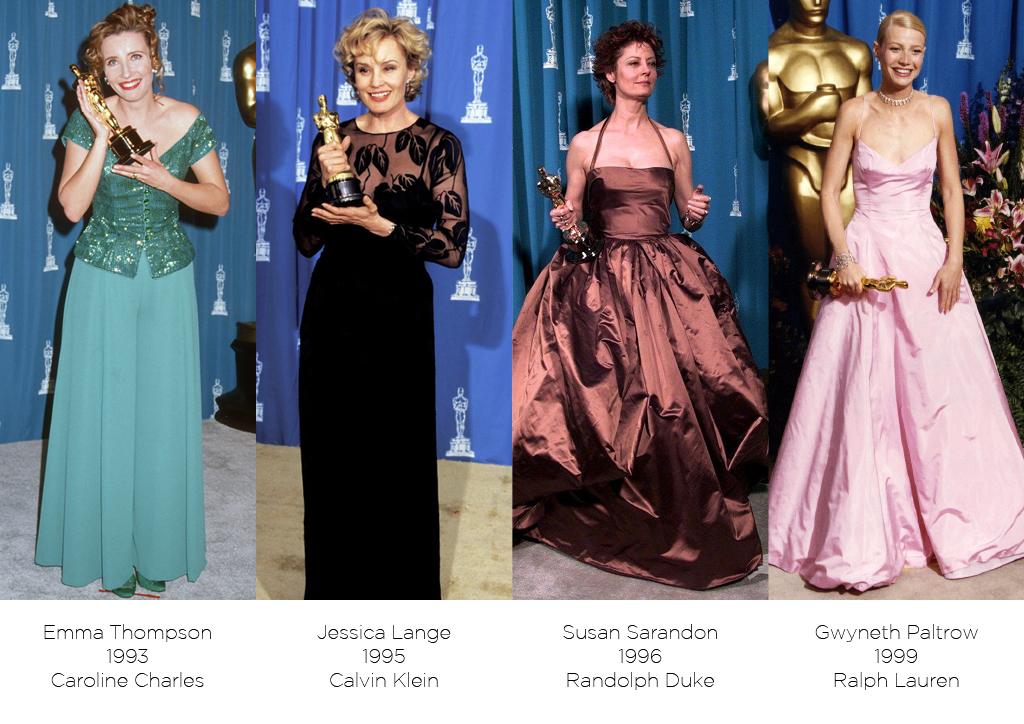The 88th Oscar ceremony will take place next Sunday, and that’s why we’re looking back at all editions to see how the actresses’ style has evolved through the years; from 1929 Janet Gaynor’s ensemble, a simple cardigan and knee-lenght skirt to 2015 Juliane Moore’s floor-length white embroidered Chanel dress.
1929-1939
 What’s most surprising of these first editions of the awards is the simplicity of the dresses the actresses wore. We don’t know the names of most of the designers, since not much importance was given at the time at who dressed whom. Another key factor one should keep in mind is that we ignore which was the prevailing color palette at the time, since photography techniques couldn’t reproduce color yet. The only way we can know about it is in small footnotes in magazines of the time and thanks to artists who would paint over the pictures.
What’s most surprising of these first editions of the awards is the simplicity of the dresses the actresses wore. We don’t know the names of most of the designers, since not much importance was given at the time at who dressed whom. Another key factor one should keep in mind is that we ignore which was the prevailing color palette at the time, since photography techniques couldn’t reproduce color yet. The only way we can know about it is in small footnotes in magazines of the time and thanks to artists who would paint over the pictures.
1940-1949
 The dresses’ majestuosity started increasing in the 40s, and, with the exception of an eternally austere Ingrid Bergman, we can see floor-length gowns, silky fabrics and lace and flowery embroidery. Even though we start to see color, it’s minoritary, since newspapers were printed in black and white so most pictures are monochromatic.
The dresses’ majestuosity started increasing in the 40s, and, with the exception of an eternally austere Ingrid Bergman, we can see floor-length gowns, silky fabrics and lace and flowery embroidery. Even though we start to see color, it’s minoritary, since newspapers were printed in black and white so most pictures are monochromatic.
1950-1959
 Hollywood’s golden age. Fashion is slowly becoming mainstream: ¿how can anyone forget Grace Kelly’s green outfit in Rear Window (1954) or Audrey Hepburns iconic look in A Roman Holiday (1953)? We now can clearly see how dresses are evolving: waistlines get narrower and skirts get fuller; following Christian Dior’s New Look. Thanks to Givenchy’s beginnings, necklines become the star of the show.
Hollywood’s golden age. Fashion is slowly becoming mainstream: ¿how can anyone forget Grace Kelly’s green outfit in Rear Window (1954) or Audrey Hepburns iconic look in A Roman Holiday (1953)? We now can clearly see how dresses are evolving: waistlines get narrower and skirts get fuller; following Christian Dior’s New Look. Thanks to Givenchy’s beginnings, necklines become the star of the show.
1960-1969
 Thanks to technology advances, in 1960 printed press used color in their pictures, so we can finally analyze the chromatic palette of the gowns. Designers started to become famous and actresses became their best communication strategy. This is an era for experimentation, with each actress dressing in their own distinctive and personal style: Signoret, icon of elegance, opposed to Streisand, styled in her fun and risky way. A very young Julie Andrews picks up her first Oscar in a simple A line yellow dress, one year after Elizabeth Taylor chose the very same color for her dress, rebelling against superstition.
Thanks to technology advances, in 1960 printed press used color in their pictures, so we can finally analyze the chromatic palette of the gowns. Designers started to become famous and actresses became their best communication strategy. This is an era for experimentation, with each actress dressing in their own distinctive and personal style: Signoret, icon of elegance, opposed to Streisand, styled in her fun and risky way. A very young Julie Andrews picks up her first Oscar in a simple A line yellow dress, one year after Elizabeth Taylor chose the very same color for her dress, rebelling against superstition.
1970-1979
 Sobriety reigned in the 70s. Yves Saint Laurent and his tuxedo opened the decade thanks to Jane Fonda, who will close these 10 years making a radical change with a romantic and bohemian floor length dress. Even though we can see some exceptions like Liza Minelli’s yellow dress, most colors are kept in a neutral palette, black and sand tones, following the hippie style that prevailed in society.
Sobriety reigned in the 70s. Yves Saint Laurent and his tuxedo opened the decade thanks to Jane Fonda, who will close these 10 years making a radical change with a romantic and bohemian floor length dress. Even though we can see some exceptions like Liza Minelli’s yellow dress, most colors are kept in a neutral palette, black and sand tones, following the hippie style that prevailed in society.
1980-1989
 The 80s madness was present too at the Oscars. One only needs to see Cher’s “dress” (if that’s what we should call it), more suited for a cabaret than an award ceremony; or Jodie Foster’s huge turquoise blue bow. Nevertheless, some actresses managed to remain elegant, such as pregnant Meryl Streep, with a very flattering gold and nude design.
The 80s madness was present too at the Oscars. One only needs to see Cher’s “dress” (if that’s what we should call it), more suited for a cabaret than an award ceremony; or Jodie Foster’s huge turquoise blue bow. Nevertheless, some actresses managed to remain elegant, such as pregnant Meryl Streep, with a very flattering gold and nude design.
1990-1999
 In the nineties we can see how floor-length becomes the rule at the Oscars ceremony. This is were the designers are able to showcase their best dresses and get recognized. Calvin Klein’s american sobriety is displayed in Jessica Lange’s elegant dress, and both Gwyneth Paltrow and Susan Sarandon chose a ball gown for their big day. Emma Thompson, faithful to her style, opted for a turquoise pantsuit, which suits her skintone very well.
In the nineties we can see how floor-length becomes the rule at the Oscars ceremony. This is were the designers are able to showcase their best dresses and get recognized. Calvin Klein’s american sobriety is displayed in Jessica Lange’s elegant dress, and both Gwyneth Paltrow and Susan Sarandon chose a ball gown for their big day. Emma Thompson, faithful to her style, opted for a turquoise pantsuit, which suits her skintone very well.
2000-2009
 Glamour ruled in the early 2000s. The award ceremonies become the designer’s catwalk, just like court balls had been in the past; and since the Oscars are the most important award in the filmmaking world, every designer wanted their spot: Valentino, Gucci, Jean Paul Gaultier and Yves Saint Laurent are only a few of the names we all now recognize because of their elegant designs, that, year after year, get all the attention.
Glamour ruled in the early 2000s. The award ceremonies become the designer’s catwalk, just like court balls had been in the past; and since the Oscars are the most important award in the filmmaking world, every designer wanted their spot: Valentino, Gucci, Jean Paul Gaultier and Yves Saint Laurent are only a few of the names we all now recognize because of their elegant designs, that, year after year, get all the attention.
2010-2015
 What suprised us the most in the last few years the presence of neutral shades, white, gold and ecru; as if they were brides walking down the aisle. They still are extremely elegant, but nobody could say they were simple at all, because of the beautiful embroidery and lace details that turn them into unique pieces that belong in a museum.
What suprised us the most in the last few years the presence of neutral shades, white, gold and ecru; as if they were brides walking down the aisle. They still are extremely elegant, but nobody could say they were simple at all, because of the beautiful embroidery and lace details that turn them into unique pieces that belong in a museum.




